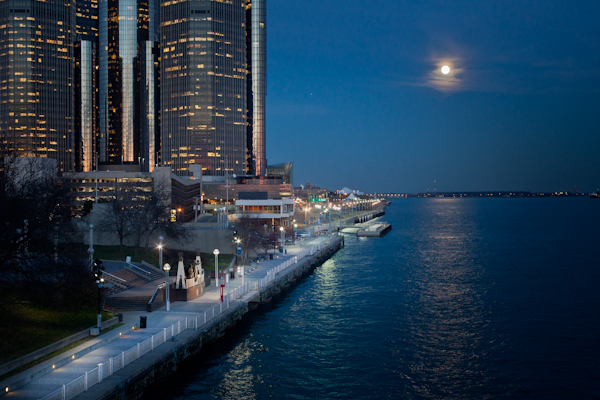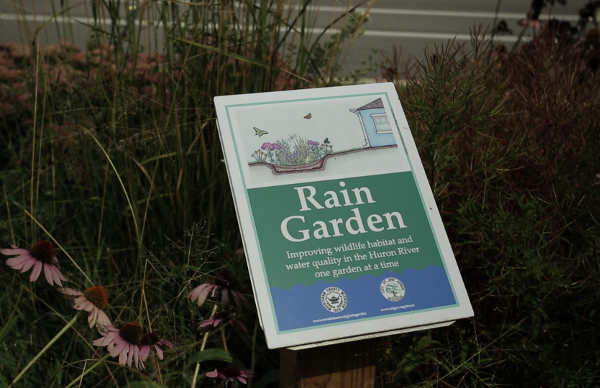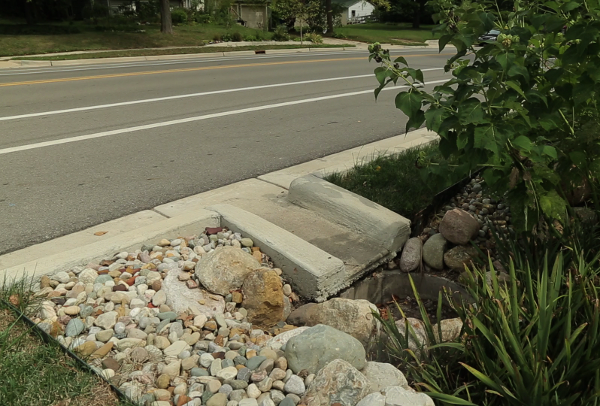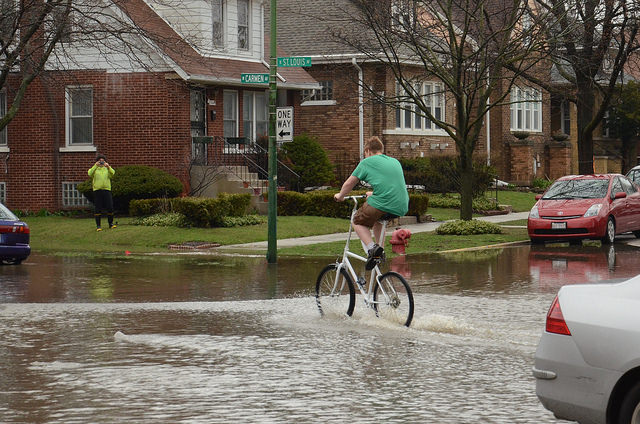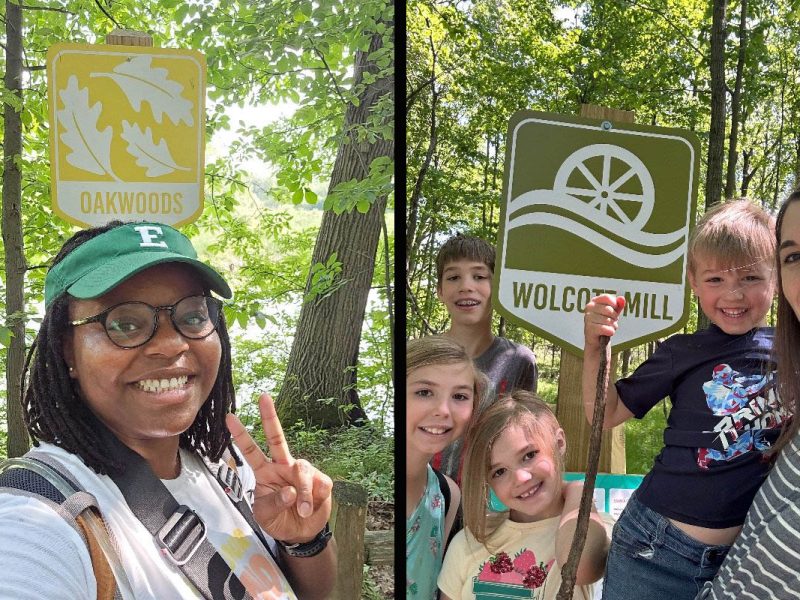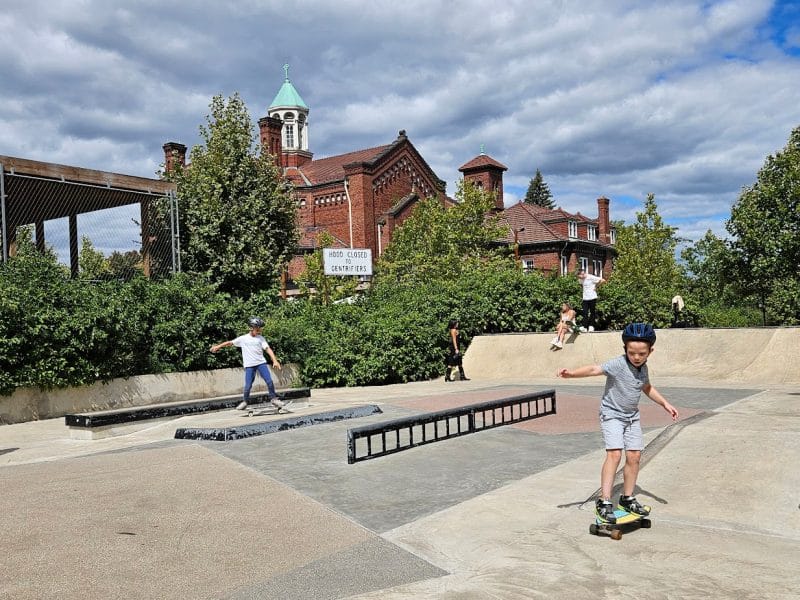Healing fractured water: How Michigan’s roadways impact our waterways
In the Great Lakes, we drive to get where we are going. And with tens of thousands of lane-miles of roadway across the basin, in both urban areas and rural areas, the impact of all of that hard surface on our waterways adds up.
This piece is made possible through a partnership with the Great Lakes Commission through the Greater Lakes project, with support from the Great Lakes Protection Fund.
In the Great Lakes, we drive to get where we are going. And with tens of thousands of lane-miles of roadway across the basin, in both urban areas and rural areas, the impact of all of that hard surface on our waterways adds up.
“If you look at the roads just in Toronto, and you put those roads end-to-end, they would extend from St. John’s, Newfoundland to Vancouver and back,” says Christine Zimmer, a senior manager of watershed protection and restoration for the Credit Valley Conservation Authority, a watershed advocacy group based in Mississauga, Ontario, and project adviser for the Greater Lakes initiative. “And they have an impact on our waterways. But it’s also a huge opportunity to do things better.”
The Greater Lakes project, managed by the Great Lakes Commission and funded by the Great Lakes Protection Fund, is striving to seize that opportunity. It’s doing so by helping local government agencies and watershed managers meet the challenge of dealing with stormwater runoff by thinking of it in a new way. They’re encouraging municipalities and citizens to see stormwater runoff not just as a problem to be dealt with, but as a resource that can be better utilized to benefit the Great Lakes ecosystem.
For one thing, road runoff causes flooding. All across the country the infrastructure to treat stormwater runoff from roads and highways is antiquated–designed to get water off roadways as quickly as possible with little regard for its impact on local ecosystems. Think pipes, roadside ditches and big stormwater ponds. The sheer volume of water that drains off roadways into waterways is often delivered as quickly as possible to local ponds, rivers or lakes, with no method of either treating it or slowing it down.
The result? Erosion of local waterways, water pollution, damage to fish habitat, and flooding.
“Some portions of roads in a municipality may have no flood control whatsoever, depending on how old the city is,” says ZImmer. “In the greater Toronto area, roughly between 60 to 75 percent of the urban area was built prior to the 1980s, or prior to both water quality and flood control.”
But where there’s a challenge,there’s also an untapped opportunity: to treat road runoff more holistically. And it’s a significant one, given the size of the cumulative impact of all of those roads across the basin, according to Zimmer.
“Our nation’s transportation infrastructure generates a massive volume of stormwater,” says Sanjiv Sinha, a vice president at Environmental Consulting and Technology and a member of the Greater Lakes team. “It’s hard to appreciate the enormity of it. As an example, let’s look at Oakland County in Michigan. The county has nearly 2,700 miles of county roads that average 24 feet wide. With an estimated average annual rainfall of 30 inches, these roads generate over five billion gallons of stormwater runoff in just one year.”
And the problem is not just confined to flooding.
Road runoff also contains all manner of pollutants, including hydrocarbon residues and heavy metals from brake linings. In winter, it’s full of road salt. In summer, rain hits hot pavement before running off into cool streams and lakes, causing thermal pollution that can impair fish habitat.
“The U.S. Environmental Protection Agency and the National Water Research Institute of Canada both cite urban runoff as one of the largest threats to our Great Lakes’ water quality and biodiversity,” says Zimmer.
An opportunity for greener infrastructure
A key component of seizing the opportunity presented by road runoff, according to Zimmer, is making wider use of green infrastructure approaches. She’d like to see more plant-rich bioswales, rain gardens, and even porous concrete implemented in road projects on a regular basis.
“What green infrastructure does is replicate the natural water cycle,” she says. “It absorbs the water whether it’s through plants or in the ground, so those small storms get absorbed on land rather than running off, which is the same as what happens in nature.”
John Jackson is the project manager for the Greater Lakes initiative. He says the project is working with municipal officials, from water utility operators to city managers to road agencies, encouraging them to talk to one another and consider how runoff can be treated more holistically as a resource.
“We see a strong need to be breaking down silos,” says Jackson. “An example of that is in road design. It’s often done by the roads department engineer, and their whole focus is on ‘how do we get it off the road as quickly as possible for the people driving down the street?’ That’s the one item in their mind. This is a classic example where transportation needs to be more integrated with other departments whose job it is to protect waterways.”
For example, says Jackson, road engineers could be talking with municipal water treatment operators to explore the potential for directing road runoff into infiltration basins that can recharge underground aquifers and support municipal water sources. Or runoff could be directed into habitat reconstruction areas to both cleanse it and provide habitat for native plants and animals–and natural beauty for communities.
“If the road engineer talked to the water supply department, they might say, ‘Hey, I don’t want all that water just pumped out somewhere else to a river or lake as quickly as possible. I want it to be infiltrating down into the ground to restore my water supply.’ If they talked to the planning department that looks at environmental issues in the municipality, they might say, “Wait a minute, I need that water to be infiltrating down into supporting the marshes’.”
Changing roads, changing minds
But changing the way we build and rehabilitate roads is a complicated endeavor.
Dan Christian is a senior water resource engineer and project manager for the consulting firm Tetra Tech. He says one of the biggest obstacles to implementing more holistic stormwater management along roadways is changing the mindsets of road engineers.
“It’s a very slow thing to change,” he says. “A paradigm shift is really what we’re after. And that just takes time. You run into a lot of issues with the mindset of ‘Well this is the way we’ve always done it. Why do we need to change?'”
And because green infrastructure technology is relatively new, there are some unknowns, he says, which tend to make road engineers uncomfortable.
“There are some real questions on the science behind the practices as it might be applied to roads,” says Christian. “For example, a porous treatment system can and does work very well on lightly used roads and parking lots. Using it on a freeway system in a cold climate like Michigan has not been done.”
Designing green infrastructure to manage both flooding and water quality takes not only an open mind on the part of the road designers, but also the right local conditions, according to Christian.
“Often green infrastructure is designed just to handle small storm events, which might be anywhere from a half inch to an inch, in which case they don’t typically have a large impact on big flood events,” he says. “It’s a function of lots of different things, like the type of soils and space available. But when we design something for a larger storm event, we can actually get meaningful impact on flood control.”
Christian points to a project he designed in the city of Detroit that was designed to address larger rain events to achieve flood control benefits.
“When I calculated what the impact would be on larger flood events, I found that I would theoretically manage at least 90 percent of the 10-year storm event and 50 percent of the 100-year storm event. So definitely it is possible, but it’s all a function of how the system’s designed.”
To design green infrastructure for flood control, Christian says, several stars need to align. Generally, the bigger the better, and that may mean substantial land area for things like swales and rain gardens. Plus the soils must be sufficiently loose to allow for infiltration. And green infrastructure that is well-positioned within the context of a larger system may be able to mitigate flooding by absorbing water where it tends to accumulate.
But while many road projects may require outsized systems owing to their large pavement areas, Christian says smaller, distributed systems have the potential to make a big impact on flooding.
“I was just on a tour in Chicago where we stopped to see a residential house, and they’ve taken downspouts and put them into rain gardens, and put a back filter on the sewer lateral, and now the house is not flooding anymore whenever rain pours down hard.”
That’s the goal of a project called RainReady, an initiative of Chicago-based Center for Neighborhood Technology. Harriet Festing is the project’s coordinator and a water programs director for CNT. She says the project’s goal is to work with individual homeowners and communities to help them find solutions to stormwater runoff.
Her work includes addressing commercial corridors and roadways. For example, RainReady has worked with the Village of Midlothian in Illinois to develop a plan for addressing flooding and water quality issues holistically using green infrastructure, as well as a variety of placemaking techniques.
“We helped them to rethink their Main Street and 47th Street,” she says. “It’s a main commercial street, but it’s not functioning well and it floods. It’s not walkable, so we’re working with them to completely rethink the purpose of that street, so that it becomes a walkable place where there’s a good retail center, and contains stormwater management as well.”
The project includes permeable paving, bioswales, and tree planting to reduce flooding, as well as bike lanes and benches. Feasting notes that it’s often a matter of exposing engineers to successful projects to open their minds to what’s possible with green infrastructure.
“Let them see these projects,” she says. “These beautiful plantings also help capture stormwater runoff. And you’re not going to be waiting for decades. You can get this stuff installed quickly.”
A turning point?
Indeed, the last five years have seen an increase in the number of test projects implemented by road agencies. Zimmer’s group worked with the city of Mississauga in Ontario to implement two permeable road pavement projects with bioretention.
“We’ve been monitoring these sites for three or four years now — in terms of water quantity and quality as well as maintenance,” says Zimmer. On July 8, 2013, Mississauga was hit by a severe rain event. “Both of those sites were in that eye of the storm. They were able to absorb 30 percent of that rainfall and reduced the peak flow of the runoff by 60 percent, and slowed it down.”
This is a benefit to aging municipal stormwater infrastructure, Zimmer says.
“The more of these techniques that we put in, the more we reduce the stress on the existing infrastructure,” she says.
And some cities are implementing policies to guide implementation of green infrastructure in roadway projects. “After the city of Mississauga saw the performance of green infrastructure on July 8, it passed a resolution that all new road projects should look at the feasibility of incorporating low-impact development techniques,” says Zimmer.
And in 2014, the city of Ann Arbor, Michigan, adopted a Green Streets Policy requiring the city to infiltrate stormwater runoff on new and reconstructed roads to protect water quality. The infiltration goal depends on local soil condition and the availability of space.
Jennifer Lawson is a water quality manager for the city of Ann Arbor, Michigan. She estimates that 25 percent of the impervious surface in Ann Arbor is roadway, and most of the stormwater runoff from these roads (and the parking lots and driveways connected to them) is untreated before it reaches local waterways.
“Ann Arbor’s Green Streets policy holds the city accountable to the same standards as any developer coming into town trying to build a building,” she says. “When we build a new public road or reconstruct a public road, we require that stormwater management be incorporated into the design.”
While the Michigan Department of Transportation has no set policy for incorporating green infrastructure into its road projects, the agency is working on incorporating the techniques into its planning process, according to Kristin Schuster, a manager in MDOT’s environmental services section. She says MDOT has completed several test projects incorporating green infrastructure.
“Green infrastructure is in the toolbox,” says Schuster. “We’re looking at pilots carefully. For us, it’s really about the context of the project; the project limit, the underlying soil and the constraints to find the right fix or mix of fixes.”
MDOT owns only 10 percent of roads in Michigan, but city and county road agencies often look to MDOT’s standards when designing local road-building standards.
“We’re in the process of learning,” says Schuster. “There’s a lot of best management practice sharing around the country…and a lot of research going on for stormwater in the past five years. We look for solutions and try and learn from and support federal research.”
What does it cost? The road to green road funding
Funding road construction is often a challenge. Adding upfront costs for green infrastructure can create an even greater challenge when budgets are tight. And because the technology is so new, there is little consensus about whether it presents a cost increase or savings in the long run.
Planners would do well to consider the whole picture, says Christian. He says green infrastructure approaches can help meet new federal requirements for treating smaller rain events to protect water quality.
“I think you have to look at comparing apples to apples,” he says. “You can’t build something for nothing. Historically we’ve been managing stormwater only for a road’s flood conditions. What are you going to spend managing it for the low flows and the water quality issues? You have to spend something.”
Lawson says costs for green infrastructure have not placed a strain on Ann Arbor’s road budget. She notes that green infrastructure is not sufficient by itself to prevent flooding in her city due to the city’s history, soils and space limitations. Conventional gray infrastructure–pipes, ponds and ditches–are still necessary to handle the really big rainfalls.
“At the end of the day, are we spending a drastic amount more? No,” she says. “Maybe we’re sending our maintenance guys out there twice more a year, but it balances out. I think maintenance is where we see some of the cost savings.”
Schuster says that while green infrastructure can help to reduce pressure on traditional gray infrastructure, it presents an added up-front cost.
“Cost is very important to us as an agency and funding is always an issue for us,” says Schuster. “That’s part of our reason to work on a pilot basis, so we can learn enough about the long-term maintenance needs of different treatment methods. Green infrastructure does add some cost to a project…it’s a supplement to the gray infrastructure.”
But Zimmer says municipalities in Ontario have come up with creative ways to pay for green infrastructure improvements to roadways.
“Some municipalities have been able to use our gas tax funding to support green infrastructure projects,” she says, “Municipalities like Kitchener or Waterloo and the city of Mississauga have stormwater rate systems. They utilize that funding to implement green infrastructure along roadways.”
And the upfront cost of adding green infrastructure into a road project can be offset in several ways, according to Zimmer. She points to pollution prevention and reduced costs related to building and maintaining traditional gray infrastructure.
“By putting in green infrastructure, you have less pollutant loading impacting our drinking water supply, and less flooding” she says. “That benefits all of us.”
And since green infrastructure may allow for a reduction in the size of gray infrastructure, cities may also be able to save on some land costs.
“Land cost can be up to three times that of infrastructure cost,” says Zimmer. “With conventional storm ponds, there’s a substantial cost to dredge and truck the sediment away. Those are costs that you don’t typically see with green infrastructure, where you primarily do landscaping, whether that’s mowing the grass or pruning the vegetation or vacuuming the permeable pavement.”
Finally, by reducing the frequency and volume of water and sediment that the gray infrastructure must handle, green infrastructure can defer maintenance and extend the useful life of ditches, ponds and pipes.
“It’s not an all or nothing solution … it’s both gray and green solutions, working together,” she says.
According to Jackson, witnessing the breaking down of municipal silos to treat stormwater management holistically, as part of an entire ecosystem, has been the most exciting part of the Greater Lakes project.
“This project has given me the chance to wander around the basin and talk with a lot of municipalities, see what they’re doing,” he says. “There are all kinds of green infrastructure projects going on, all over the Great Lakes Basin. It’s happening out there, and more and more people are getting serious about it. I don’t think it’s going to be much longer till we get to the stage of saying, “Hey, wait a minute, this really does work.'”
—
Policies & standards for green roadways across the Great Lakes
- Illinois: Chicago Department of Transportation Sustainable Urban Infrastructure Policies and Guidelines
- Indiana: No official policy found.
- Michigan: No official policy; green infrastructure pilots being implemented on a test basis.
- Minnesota: No official policy found.
- New York: No official policy found.
- Ontario: Building Together plan calls for encouraging municipalities to utilize green infrastructure. City of Mississauga resolution to consider green infrastructure on road development.
- Ohio: No official policy found.
- Pennsylvania: No official policy found.
- Wisconsin: No official policy found.
Outside of the Great Lakes:
- Sustainable DC Plan: The plan calls for increasing green infrastructure.
- Virginia Department of Transportation’s Chesapeake Bay TMDL Action Plan calls for green infrastructure to help achieve goals.
- North Carolina Stormwater Offset Program calls for dealing with stormwater through an offset program including roadways.
- Portland Green Streets Program includes technical designs and plans for implementing green infrastructure in roadways.
More information:
- Managing Wet Weather with Green Infrastructure Municipal Handbook- Green Streets | USEPA
- Great Lakes Green Streets Guidebook | Southeast Michigan Council of Governments
